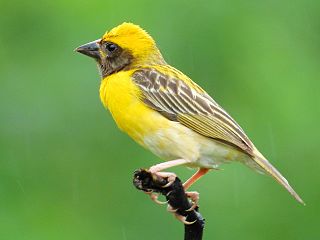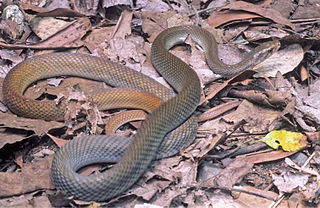
The blue-tailed bee-eater is a near passerine bird in the bee-eater family Meropidae. It is widely distributed across South and Southeast Asia where many populations are strongly migratory, and seen seasonally in many parts but breeding colonially in small areas across their range, mostly in river valleys, where they nest by tunneling into loamy sand banks. They are seen mostly in open habitats close to water.

Toxicofera is a proposed clade of scaled reptiles (squamates) that includes the Serpentes (snakes), Anguimorpha and Iguania. Toxicofera contains about 4,600 species, of extant Squamata. It encompasses all venomous reptile species, as well as numerous related non-venomous species. There is little morphological evidence to support this grouping; however, it has been recovered by all molecular analyses as of 2012.

The common trinket snake is a nonvenomous constrictor species of colubrid snake native to south Central Asia.

The baya weaver is a weaverbird found across the Indian Subcontinent and Southeast Asia. Flocks of these birds are found in grasslands, cultivated areas, scrub and secondary growth and they are best known for their hanging retort shaped nests woven from leaves. These nest colonies are usually found on thorny trees or palm fronds and the nests are often built near water or hanging over water where predators cannot reach easily. They are widespread and common within their range but are prone to local, seasonal movements mainly in response to rain and food availability.

Calliophis is a genus of venomous elapid snakes, one of several known commonly as oriental coral snakes or Asian coral snakes.

The Colubrinae are a subfamily of the family Colubridae of snakes. It includes numerous genera, and although taxonomic sources often disagree on the exact number, The Reptile Database lists 717 species in 92 genera as of September 2019. It is the second largest subfamily of colubrids, after Dipsadinae. Many of the most commonly known snakes are members of this subfamily, including rat snakes, king snakes, milk snakes, vine snakes, and indigo snakes.

Elaphe carinata, the king ratsnake, is a species of Colubrid snake found in Southeast and East Asia.

Lycodon is a genus of colubrid snakes, commonly known as wolf snakes. The Neo-Latin name Lycodon is derived from the Greek words λύκος (lykos) meaning wolf and οδόν (odon) meaning tooth, and refers to the fang-like anterior maxillary and mandibular teeth. They are nonvenomous, but many members of this genus strongly resemble the venomous kraits in appearance, an example of Emsleyan mimicry.

Coelognathus helena monticollaris is subspecies of nonvenomous constricting snake in the family Colubridae. The subspecies is native to the Western ghats of India.

Coelognathus is a genus of seven rat snakes from South and Southeast Asia that were formerly assigned to the genus Elaphe. Based on morphological evidence and protein similarities, in 2001, Helfenberger revalidated the name Coelognathus that had originally been proposed by Leopold Fitzinger in 1843. The distinction between Coelognathus and Elaphe was further supported by mitochondrial DNA sequence and additional morphological evidence in 2005.
Rhinophis philippinus, also known as Peter's earth snake or Peter's Philippine earth snake, is a species of snake in the family Uropeltidae. It is endemic to Sri Lanka.

Coelognathus flavolineatus, the black copper rat snake or yellow striped snake, is a species of colubrid snake found in Southeast Asia. This species was previously recognized in the genus Elaphe.

The Indonesian ratsnake is a species of snake of the family Colubridae.

Coelognathus erythrurus, commonly known as the Philippine rat snake, is a species of snake of the family Colubridae.
Coelognathus enganensis, the Enggano rat snake, is a species of nonvenomous snake in the family Colubridae. The species is found in Indonesia.
Liopeltis philippina, commonly known as the Philippine liopeltine snake, is a species of nonvenomous snake in the family Colubridae. It is found in the Philippines.
Lycodon philippinus , the Philippine dryocalamus, is a species of snake in the family Colubridae.
Calliophis philippinus, the Philippine coral snake, is a species of snake of the family Elapidae.











